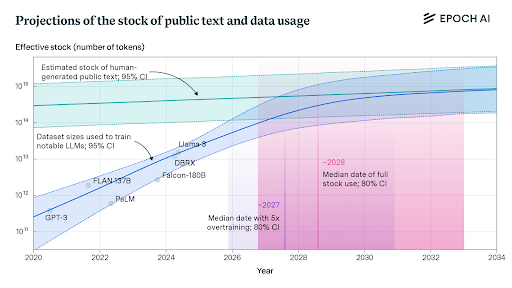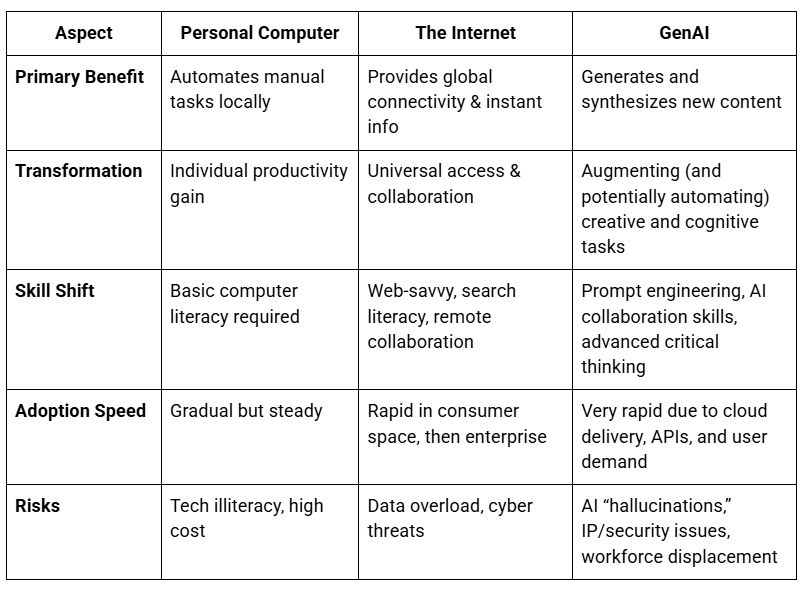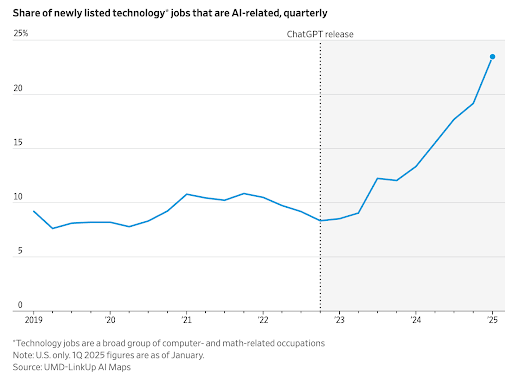
How AI Impact on Work May Influence Enterprise AI Adoption
-
 Written by
Written by -
CategoryData Transformation
-
Published DateApril 29, 2025
We live in the information age. More data is generated in a day today than the combined information generated by humans since writing was invented thousands of years ago. More so, since the invention of the PC and later the internet, knowledge workers’ share of economic value has never been higher. Our modern societies are defined by our work with our minds, not our hands.
For the past twenty years, the digital world has been the basis of how we learn, work, communicate, and even have relationships with other human beings. Technologies like search engines and smartphones have made an almost infinite amount of information available for anyone who dares to look for it. Better, in real time, and virtually free. However, if information retrieval has never been easier, processing and generating knowledge from it remains a human activity. One may say that deriving meaningful knowledge from so much information is even more challenging than before: curating and removing signals from the noise requires domain knowledge, usually constructed through years of formal education, life experiences, and social engagements that define what we typically consider an “expert.”
Creating knowledge is both complex and where the value lies. Technologies that help us collect and consolidate information in the form of unstructured or structured data can only go so far. Despite the apparent increases in productivity that the PC, the internet, or, more recently, Big Data brought to the economy, the amount of knowledge workers needed to process all that information increased. In economic terms, trillions of dollars are spent annually on the millions of office staff, management, consultants, and analysts who create knowledge from information.
This is why GenerativeAI is transformational. Now, we have a technology that not only retrieves information as a search engine does but generates what seems to be actual expert knowledge. And all in natural language, which anyone who can read and write can use out-of-the-box.
But how is GenAI so good? Is it really intelligent? Will it replace humans in a matter of years, as many AI influencers try to sell it on Social Media? Or is it just hype? As is usually the case, the reality lies somewhere in the middle.

Different views on AI’s future, from breakthrough to burnout.
Limits of AI learning
Transformer-based Large Language Models (the architecture behind the most advanced GenAI tools) are but an evolution of machine learning techniques trained on immense amounts of data (estimates indicate that training models may use the entirety of publicly available internet data between 2026 and 2034). As statistical methods, LLMs do not think the same way humans do. They work by predicting the next token (i.e., a word) given the previous context and the relationships between words the model learned during training. That makes GenAI especially prone to hallucinations and inaccurate predictions since the models do not really “understand” the underlying processes or concepts the words represent.

Estimates indicate that training models may use the entirety of publicly available internet data between 2026 and 2034. Source: Epoch AI
AI vs PC vs Internet
Sooner or later, all knowledge work will be influenced by AI. Unlike earlier transformational innovations such as the PC or the internet, companies and institutions won’t be able to contain or control it. GenAI tools are too easy to use (natural language), cheap (you can get the most advanced models for a couple of hundred dollars a month,) and the rewards are too high (people can accelerate, if not automate, dozens or hundreds of day-to-day tasks). However, we can’t look into the potential gains of GenAI with only a static lens. As GenAI adoption increases and processes are redesigned, many activities will lose value or simply cease to exist. If one can automate a report that took a week to create with a single prompt, what will be the marginal value of that report creation process anyway?

Short-term benefits vs long-term risks
Due to the widespread use of cloud tools and easy APIs, AI adoption will be much faster than the PC or the Internet. We are talking 3 to 5 years versus 1 or 2 decades to reach similar usage levels in the workspace (or even faster!). The most successful use cases for enterprises will be internal and require human signoff. There is still too much risk to automate core processes entirely with AI due to the non-deterministic nature of LLMs. And there is a chance it will remain so for quite some time. The potential benefits are still immense in aggregate: companies already report up to 40% productivity gains with AI in small-scale experiments. Even if replacing individual employees may not be a good idea, there is a clear overall impact on the workforce.

Growth in AI-related jobs is growing exponentially. Source: WSJ
However, productivity gains in small-scale experiments are different from full-scale organizational change. In the short term, it’s fair to say that employee AI adoption will be much faster than organizational change. By applying AI to traditional processes, workers can gain an edge over the company themselves. Companies must redesign work and education to obtain value from Gen AI-augmented work.
The widespread use of AI brings together some serious security and governance risks. While many companies are mainly concerned about IP leakage for LLM training, we believe most risks will come from ill-designed systems and/or processes with AI. Recent large-scale acquisitions of cloud security firms by hyperscalers are a symptom of the size of this potential risk and the amount of investment that will need to be made by enterprises in the near term. As we shall see, this risk will be higher in the longer term as deep hands-on security expertise could be more challenging to find in the workforce.

Example of AI coding going wrong (“vibe coding”)
In the longer term, the same reasons that make AI so valuable for knowledge workers also make it dangerous. By replacing knowledge generation, there is a potential de-skilling of the workforce. Over-reliance on AI can lead to atrophy of key abilities (e.g., writing, coding, detailed analysis, security), mainly if humans no longer perform these tasks regularly.
Companies also risk losing tacit knowledge. Subtle insights gained through hands-on experience may diminish, making organizations vulnerable if AI is incorrect or unavailable.
Finally, we should expect pressure on entry-level jobs and wage polarization in the workforce. Repetitive or template-based tasks (e.g., basic content writing, junior coding) may see automation, and workers who master AI tools or provide high-level expertise can command premium wages. In contrast, others may experience stagnation or displacement.
How can companies benefit from it?
It seems clear right now that some AI copilot will be a must-have technology for any company in the near term. However, this will be a defensive move. Do it or die. Technology investment won’t be enough to drive long-term strategic value from AI, especially when the same technology is available to anyone with money to spend.
To drive real value, companies must redesign their organizational structure and streamline processes with AI. Additionally, enhancing what already makes you different is key: your brand, culture, and product. Instead of investing in AI as the end goal, look for opportunities to do things that are now possible because of AI.
Instead of just replacing workers, build new roles and introduce reskilling opportunities. While there will be a rising demand for AI engineers, data curators, and prompt specialists, the most significant value will come from redefining traditional roles with AI.
Companies will also need to be much more proactive regarding talent development strategies. Random work experiences that help develop tacit knowledge and seniority will often disappear, so they must be replaced by well-structured training programs and processes. As AI replaces entry-level roles, a talent shortage in the long run will unexpectedly impact salaries and hiring, deepening the talent shortage already happening in tech-related positions.
The importance of a modern data platform
Unfortunately, most companies’ data platforms are simply not ready. If modernizing their data platforms was already a top priority for CDAOs and CIOs before GenAI came out, it is even more critical now, with the added risk that the whole business could become obsolete.
The AI-ready data platform has all the requirements than before: structured and unstructured data processing, data governance, observability, and operations, with the added complexity of developing, deploying, and monitoring AI agentic systems. It also needs specialized teams and up-to-date processes.
How can frameworks like IndiMesh help?
Conclusion
About Indicium

Daniel Avancini
Stay Connected
Get the latest updates and news delivered straight to your inbox.




